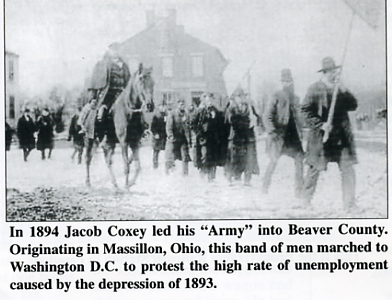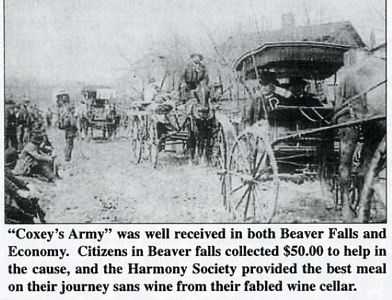
Click Here to Return to Milestones
In the year 1894, Beaver County was invaded
by an army led by Jacob Coxey, a populist leader from Massillon,
Ohio. Coxey's Army wasn't a real army and it was not here to fight,
only to pass through, gathering recruits on its historic march
to Washington, D.C. to protest the high rate of unemployment caused
by the depression of 1893. This protest march was the first time
in American history that average citizens banded together to present
their complaints in such a way to the federal government.
The leader of this so-called army was Jacob Coxey, an Ohio businessman and minor political figure, who opposed President Grover Cleveland's economic policies. Coxey believed that the best way to bring the nation out of the disastrous depression was to expand the money supply and give unemployed workers government jobs building roads and other public facilities throughout the country - a very radical idea for that time in our history. To press his point, Coxey called for a gathering of unemployed workers from throughout the country to join him in a march to Washington to present a petition to Congress demanding the creation of public works jobs to help the unemployed.

Coxey's Army, consisting of approximately 500
men, that included a marching band, began its trek from Massillon,
Ohio, on March 25th, 1894, on the first leg of a long journey
through Pennsylvania and Maryland, that would eventually end in
Washington, D.C. Originally named by Coxey, the "Commonweal
of Christ," the newspapers dubbed the marchers "Coxey's
Army" because of their military manner as they entered cities
along the route. The procession that greeted Beaver County residents
as described by Franklin Taylor Nevin in his book, The Village
of Sewickley, must indeed have been an interesting sight:
""General" Coxey himself in a buggy drawn
by a white horse was recognized at once. Close on his heels followed
the news-writers representing papers in all parts of the country.
These occupied vehicles of various and weird description, which
were followed by a long line of dusty and bedraggled marchers,
the "Army of the Commonweal." Here and there appeared
an officer on horseback. Most prominent was picturesque Carl Browne,
theosophist and near-anarchist, Coxey's chief of staff, and, riding
beside him, the mysterious "Unknown," called also "Unknown
Smith," the leader from the far west, whose identity remained
a secret to the end. There was "Cyclone" Kirkland, astrologer,
meteorologist, "ordnance store officer" and recruiting
sergeant; Marshal Broderick of the Chicago commune, in charge
of the tents; Iler, the Commissary officer, commonly called "Weary
Idler" by the correspondents, with his sombrero worn at a
rakish tilt; Oklahoma Sam on a wiry western horse with cowboy
trappings, galloping about as aide de camp to Browne. And now
as the head of the procession is about to enter the town, Jasper
Johnson, the standard bearer, climbs out of a buggy, unfurls the
American flag and takes his place at the head beside General Coxey,
accompanied on one side by his yellow cur dog "Bunker Hill"
and on the other, by the half-breed Jackson, long-haired and picturesque,
belted with wampum and swinging a big axe.."
Nevin goes on to describe the reception that the army received
in two Beaver County communities:
"Especially cheering had been the reception accorded
the marchers in Beaver Falls, where a warmly enthusiastic crowd
applauded the speeches and took up a collection of $50.00 or more
to help along the cause, while one of the hotels gave free lodgings
to the officers and their mounts. This luxurious over-night rest
put so much pep in the leaders that a rather fast pace was set.."
"The Visit to Economy was no less cordial than Beaver Falls
in its greeting, for Trustee John S. Duss of the Harmony Society
had a warm feeling for Coxey, and set about to show that he knew
how to treat the weary travelers. Warm and appetizing food was
provided in abundance at the Economy camp which Coxey named "Valley
Forge," but the ragged army was not made free of the famous
old wine cellars of the Society. A wise precaution, undoubtedly.
Cheered thus by "the best meal to date," the Army resumed
its march towards Pittsburgh on the afternoon of April 2nd."
As they left Beaver County, the army marched on through Pittsburgh
and east, passing into Maryland before finally arriving in the
District of Columbia on April 29, 1894. Several days later, Coxey
led his followers down Pennsylvania Avenue to the Capitol where
they were confronted by police officers. Arrested for violating
a law against groups using the Capitol grounds for political action,
Coxey spent almost twenty days in jail, while his followers waited
patiently throughout the summer for some action on their petition
by Congress. That action never came.

Coxey's protest failed in its ultimate goal to force Congress to enact sweeping social legislation to provide work for the unemployed, but it helped to establish the blueprint for how President Franklin Roosevelt approached the great depression of the 1930's. Perhaps, more significantly, Coxey's "protest in boots" marked the first time in our history that common Americans banded together for a new style of protest: A social action that would be exercised by Americans again and again throughout our history from veterans marches through the Vietnam War and up to the present day.